Seasons – April 2022
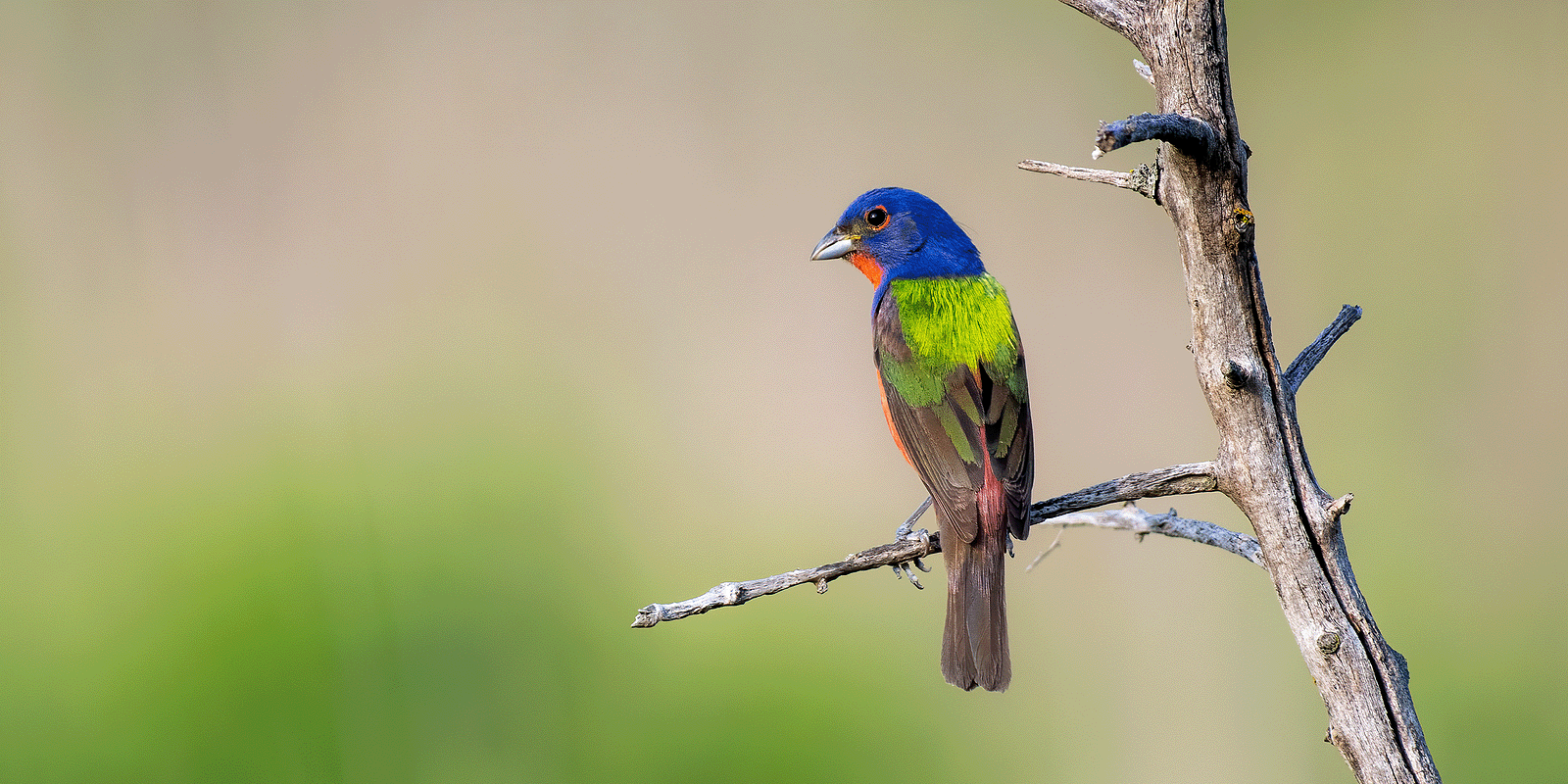
From the Plateau Land & Wildlife Management Team
The winter months are officially behind us, and spring has sprung. We are always happy for spring’s arrival for so many reasons; the budding trees, the greening grass, newborn wildlife, and the slowly warming weather are all wonderful. If you take a minute to notice the transformation happening around you, you can’t help but be in awe.
In this issue of Seasons, you’ll find guides by Plateau’s team of biologists and Wildlife Management staff to help you enjoy the changing landscape and make the most out of the spring season. We’ll cover tips for native pollinators, birds you can see during spring migration, spring pest control that can count as a Wildlife Management activity, educational webinars, news for Texas Landowners and more.
We hope you enjoy all this edition of Seasons has to offer and, as always, we are here to help when you need it!
Until next Seasons,
The Plateau Team
Table of Contents
Managing for Native Pollinators
Birds You Can See on Your Property This Spring
Wildlife Management Activity Reminder: Imported Red Fire Ant Control
How Spring Migration Affects Landowners
Braun & Gresham attorney elected as Hays County Bar president
Catch us on the Road!
News for Texas Landowners
Managing For Native Pollinators
By Shane Kiefer, Director Of Ecological Services, Certified Wildlife Biologist, Senior Property Tax Consultant
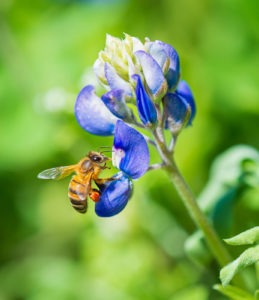
You have likely heard a lot about the importance of pollinators in the last few years. Concerns about declines in pollinator health are not new, but they received official attention with a Presidential Memorandum to create a federal strategy to promote pollinator health in June 2014.
Much of the attention given to pollinators goes to honeybees due to their importance to our agricultural crops. But there are over 700 native bee species that occur in Texas, not to mention all the butterflies, moths, flies, beetles, bats, and other animals that act as pollinators. Many of these also pollinate crops and are essential to the survival of the native plants that depend on them – including the beautiful wildflowers we are currently enjoying.
While planting pollinator-friendly species such as native wildflowers or host plants for butterflies is an excellent management activity, there are many other options that follow some general rules to promote native pollinators. Some are as simple as minor adjustments to things you may already be doing, and can count towards your qualifying Wildlife Management activities. Many will also encourage other wildlife species to use your property.
1) Promote diversity
Don’t just focus on types of plants available but also on the structure of the vegetation and natural shelter available in your habitats. This often means doing less – mow less, weed less, clean up less. When planting, be sure to include species that bloom at different times during the growing season. Pollinators need food even after the spring flowers are gone.
2) Use what nature gives you
Those native weeds and lesser-known wildflowers are important, too. If your site already has natural diversity avoid doing things that discourage it, such as frequent mowing or overgrazing (especially during the growing season) or using herbicides indiscriminately. I commonly see landowners ask about controlling that tall, leafy weed under their trees, not knowing that frostweed (Verbesina virginica) is an attractive and important butterfly nectar source in the fall.
3) Work in patches
The opposite of diversity is uniformity. A clean, uniform pasture or forest may be visually appealing to our pastoral sensibilities, but it does not provide diversity (see Rule 1). For example, when mowing an area, mow in strips or small blocks, leaving uncut areas in between and along edges. Even after the flowers are done blooming, standing vegetation provides cover and nest sites for insects and other small wildlife. This can also apply to planting projects. If you don’t have space or budget to plant large areas for pollinators, even small patches can provide benefits.
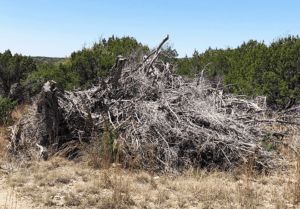
Brush piles are a very important habitat element for many different kinds of wildlife. They provide cover from predators and places for nests, hives, and dens.
4) Embrace a little mess (even if only in areas you can’t see)
Standing dead trees, dead branches, rotting logs, and brush or wood piles provide nesting sites for many native bees. Leaf and other vegetative litter provide shelter for adult and immature insects. Retain these in areas where they do not pose a safety hazard or fire risk. Similar to cavity-nesting birds, you can supplement these natural nest sites with artificial bee houses for mason bees, bumblebees, and others.
5) Start at ground level
Part of structural diversity is providing patches of bare ground for pollinators. Many native bees are ground-nesters and need scattered patches of undisturbed, bare soil. This is one of many reasons that sod-forming, non-native grasses like bermudagrass or bahiagrass are bad for wildlife. In addition to choking out plant diversity, they also eliminate structural diversity. Native bunchgrasses will naturally provide semi-bare patches of soil, and spot-treating non-native grasses with herbicides, flash grazing, or winter discing to expose soil can enhance old pastures for pollinators.
The list of beneficial management activities is long, but if you follow these general guidelines, you will be promoting pollinator health whether in your backyard, your pasture, or your timber stand. So plant those flowers and host plants, but also skip some mowing, let that corner of your backyard grow a little wild, leave some dead limbs, and let a few weeds grow. Our native pollinators will appreciate it.
As an additional resource, check out Texas Parks & Wildlife’s guide providing Management Recommendations for Native Insect Pollinators in Texas.
Have questions about managing for native pollinators in your Wildlife Management Plan? Please contact us at [email protected] or (512) 894-3479.
Birds You Can See on your Property this Spring
By Danielle Belleny, Staff Biologist, Senior Property Tax Consultant
Each year, billions of birds engage in an annual cross-continental migration that transports them from their tropical wintering grounds in South and Central America to their breeding grounds in North America. The migrant birds begin to trickle into Texas around late February as the warming weather promises lush and resource-plentiful times ahead.
Landowners will begin to notice the colorful migratory birds that settle within the habitats on their properties become increasingly noticeable, especially by sound. The colorful, feathered denizens bring cheerful songs that are used to defend their breeding territories as well as attract a mate. Additionally, for nature enthusiasts, the songs and sights provide a season’s worth of entertainment and a scientific way to assess bird populations in an area.
Here are some migratory bird species that landowners may encounter and support on their properties, separated by Texas regions:
Hill Country
Golden-cheeked Warblers have radiant yellow faces accented with black crests and a contrasting white belly. They are highly specialized and only breed in mixed juniper-oak woodlands in central Texas. The woven nests of these warblers are made from strips of old-growth Ashe juniper bark. Golden-cheeked Warblers eat insects including beetles, caterpillars, and flies. Males can be heard belting their loud buzzy songs beginning in March. Drastic declines in Golden-cheeked Warbler populations can be attributed to the loss of mature Ashe juniper habitat required at their breeding grounds. Golden-cheeked Warblers are listed as Federally Endangered under the US Fish & Wildlife Service. Properly managing breeding habitats for Golden-cheeked Warblers will help keep this local Texas species around for future generations to experience. Expect to see Golden-cheeked Warblers in this region from March to September.
The lemony Scott’s Orioles are identified by their dazzling yellow body feathers seen in both males and females. The bodies of the males are contrasted with black wings, head, bib, and tail. Female Scott’s Orioles lack black markings and have olive-colored head and wing feathers. Scott’s Orioles forage in taller vegetation for insects and can be frequent bird feeder visitors when enticed by fresh orange slices and grape jelly. Scott’s Orioles are closely associated with yuccas. The plant’s leaves provide nesting materials and flowers provide nectar for the birds to eat. Expect to see Scott’s Orioles in this region from March to October.
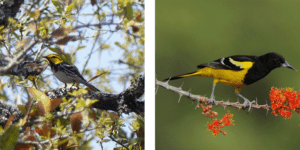
Golden-cheeked Warbler (left) and Scott’s Oriole (right)
East Texas
American Redstarts are Halloween-themed warblers that have sweet songs that sound like squeaky wheels. Males have black feathers covering their heads, wings, and tails with bright orange flashes of color on their sides and outer tail feathers. Females have pale gray heads, rusty orange backs and wings, and yellow feathers extending from their wing pits to their chests. American Redstarts breed in deciduous forests and mixed woodlands near lakes, streams, and swamps. Redstarts primarily eat insects, often catching them mid-air, and occasionally eat berries. They can be seen flicking and fanning their tails while they forage in tree canopies. Expect to see American Redstarts in this region from April to June.
Ruby-throated Hummingbirds are the infamously bejeweled fast-moving birds seen darting from flower to flower delicately collecting nectar with their elongated beaks. They can be found in woodland and brushy environments. The bird’s buzzing sounds are caused by their wings beating 50 times per second. Alternatively, they can be heard marking chirping calls while dueling for a flower or their favorite spot at the hummingbird feeder. Plant native flowers that bloom red or orange to attract more hummingbirds to your yard. A careful eye can spot the tiny nest of a Ruby-throated Hummingbird. They are constructed of spiderwebs, lichen, and mosses and are wedged securely in the terminating ends of deciduous tree branches. Expect to see Ruby-throated Hummingbirds in this region from March to November.
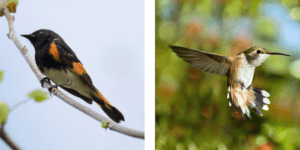
American Redstart(left) and Ruby-throated Hummingbird (right)
Central Texas
Scissor-tailed Flycatchers are easily identified by their long forked tail that can reach 9 inches in length. The flycatcher opens and closes its tail during its high-energy acrobatic flights. The salmon pink wings, ashy grey body, black-tipped tail, and unmistakable silhouette are best observed while the bird is in flight. Scissor-tailed Flycatchers forage grasslands for insects, about 50% of their diets are grasshoppers. You can commonly find scissor-tailed in small groups chattering on telephone wires and dotting the canopies of trees along urban and rural roads. Expect to see Scissor-tailed Flycatchers in this region from March to November.
American Golden-Plovers are shorebirds commonly found in pastures, tilled farmland, and weedy shallow ponds. They have one of the longest migrations of any shorebirds and fly from their South American wintering grounds to their arctic breeding grounds in Alaska and Canada. American Golden-Plovers can be seen stopping in Texas to fatten up on invertebrates, seeds, and berries before they complete their migration. They can be noticed by their run-stop-scan feeding technique in flat fields or by their rapid series of whimsical whistling calls. In breeding plumage, both males and females look very similar. They have black heads with white neck sides and earthy brown shades accented with golden flecks on their backs. Expect to see American Golden-Plovers in this region from March to June and again from September to December.
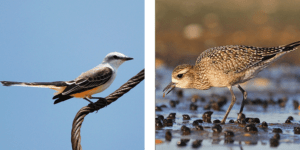
Scissor-tailed Flycatcher (left) and American Golden-Plover (right)
Whether you are in Wildlife Management or not, an exciting activity for many landowners is watching and identifying the various birds that frequent your property. With spring upon us and migration underway, now is the time to get outside on your property and see which species of birds are prevalent. Need some help getting started? Partner with Plateau for a Spring Breeding Bird Surveys. These surveys are a great opportunity for landowners to practice their birding skills and tour their property with a professional wildlife biologist while visiting a number of bird survey stations to detect birds either through visual or auditory observation. Detailed reports are produced with all species and numbers observed, brief habitat and location descriptions for each station, counting as a Wildlife Management Activity.
If you’re interested in learning more about Plateau’s Spring Breeding Bird Survey, or would like to schedule one for your property call (512) 894-3479 or email [email protected].
Wildlife Management Activity Reminder: Imported Red Fire Ant Control
By Kameron Bain, Landowner Account Manager
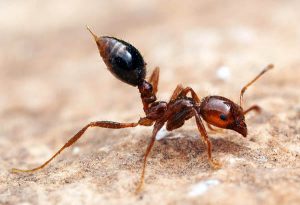
Warmer weather means spring is here – and so are the fire ants. As mounds start to appear on your property, it means an increase in ant activity, which is bad news for other insects and arthropods, ground-nesting birds, and small wildlife of all kinds.
Imported red fire ants are an invasive species from South America first coming to this country in the 1930’s. Not only are they a nuisance to humans, but they also impact wildlife including deer, quail, and other ground nesting birds. Fire ants prey on and compete with other insects for the same food sources. Beyond direct predation on larger wildlife, the reduction in essential insects and other arthropods that nesting birds and small mammals need creates a ripple effect in the ecosystem as a whole, resulting in a shortage of food up the chain and a reduction in species diversity.
Plateau recommends treating imported red fire ants in the spring through early summer and again in the fall. Spring treatments reduce ant numbers when wildlife are most vulnerable to predation, while fall treatments help reduce the number of mounds that appear the following spring. Now is a great time for your first treatment of the year.
Treatment Recommendations:
If at all possible, spot treat individual mounds with bait-style insecticides like Extinguish Plus or Amdro Pro that require the ants to ingest it. This reduces impacts to non-target ants and other insects. Contact insecticides like those containing pyrethrins can be effective when spot-treating as well, but will kill other insects that they contact. Organic treatments using spinosad and citrus oils are also available if you prefer to avoid synthetic insecticides.
If you have more than 20 fire ant mounds per acre, then you might consider broadcasting baits following the label directions. Keep in mind that this technique will likely impact native ants more than individual mound treatments.
Be sure to note the date of any treatments, take some example photos of treated mounds, and note the area you treated on a map to help ensure you covered the acreage required in your wildlife management plan.
A good program is both highly effective in treating fire ants and will benefit native wildlife as well. Always follow label directions before applying, and if you have grazing livestock on your property or cut hay, be sure to check for any restrictions on your chosen product.
Plateau’s Imported Red Fire Ant Treatment and Control uses GPS technology and aerial imagery to accurately locate treatment areas and eliminate fire ants with an effective, compliance-ready dual action insecticide treatment. To schedule a IRFA treatment for your property, contact us at [email protected] or (512) 894-3479.
How Spring Migration Affects Landowners
Billions of birds are on the move across North America this spring as they migrate to their northern breeding areas.
Certified Wildlife Biologist James Hall details the types of migratory species that can be spotted in Texas this season, and actions landowners can take during the season to help native Texas wildlife. For those in Wildlife Management, Hall explains how certain Wildlife Management Activities can support songbirds and other migratory birds as they pass through Texas this spring.
Back to TopBack to Top
Barton Elected as new Hays County Bar President
Carly Barton, Braun & Gresham attorney and counselor, has been elected as the Hays County Bar Association’s president for 2022.
A member of the Association since 2018, Barton will act as the spokesperson for the legal community in Hays County and assist with the organization’s monthly meetings, along with educational and community service events hosted for and by members.
The Hays County Bar Association is a nonprofit professional organization of attorneys in the Hays County area. They organize CLE opportunities, volunteer their legal services and attend social events.
“The legal community in Hays County is pretty tight-knit. Because Hays is such a large county, the bar association provides opportunities to come together and discuss the legal challenges in our local community,” said Barton.
Before becoming president, Barton served a partial term on the Association’s board in 2021 and assisted in organizing and hosting the Hays County Bench Bar – an annual accreditation and networking conference. The Bench Bar provides attendees educational credits for legal courses, as well as an opportunity to meet with and learn from local and appellate judges.
Barton has found that her membership and subsequent presidency at the Hays County Bar Association has provided her access to a knowledgeable and devoted network of peers.
“Hays County is full of smart, passionate, local attorneys that provide their clients with great legal advice,” said Barton. “You don’t have to travel far or to a big city to access the legal services you need.”
Barton balances her role as the Bar Association’s president with her position as an attorney at Dripping Springs law firm, Braun & Gresham. As a landowner advocate for the firm, she helps property owners resolve their land issues by defending their rights and representing their interests throughout all stages of litigation.
For more information about Barton and her work with Braun & Gresham law firm, visit: https://braungresham.com/meet-the-team/carly-barton/
Catch Us on the Road!
 Join us on on the road this month! Plateau Representatives are partnering with organizations around the state to cover information on a broad number of common issues facing Texas landowners! Our experts will be on hand and ready to discuss how a Wildlife Management valuation, more commonly referred to as “Wildlife Exemption”, can simplify owning land in Texas.
Join us on on the road this month! Plateau Representatives are partnering with organizations around the state to cover information on a broad number of common issues facing Texas landowners! Our experts will be on hand and ready to discuss how a Wildlife Management valuation, more commonly referred to as “Wildlife Exemption”, can simplify owning land in Texas.- April 2 – C21 Farm and Ranch Expo
Kerville, Texas
https://c21texasranches.com/farm-ranch-expo-2022/ - April 8– Owning Your Piece of Texas
Burnet, Texas
https://agriliferegister.tamu.edu/site_files/materials/material_1250.pdf - April 10 – Driftwood Heritage Festival
Driftwood, Texas
https://laketravis.com/events/driftwood-heritage-festival/ - April 22 – LCRA Lone Star Lands Workshop
Dripping Springs, Texas
https://www.coloradoriverlandtrust.org/event/lone-star-lands/
Stay tuned to learn about additional upcoming events!
News for Texas Landowners
Is Texas Hill Country in danger of being ‘loved to death’?
Article by Henry Gass for The Christian Science Monitor

Deep in the heart of Texas, the traffic is backed up for almost a mile.
It’s a jarring sight for long-time residents of the Hill Country, a rural oasis of scrubby green hills, crystalline water, and bright white limestone west of Austin and San Antonio. But it’s not the only sign that change is afoot in this once rustic and hardscrabble region of the Lone Star State. Eighteen-wheelers roll over the narrow country roads, and housing developments dot the limestone hills. Home values are climbing as low-wage workers struggle for housing. Meanwhile, sewage systems are hitting capacity, and drinking water supplies may not last through the next long drought.
Dripping Springs celebrates Texas Bird City designation
Article by Riane Roldan for KUT, Austin NPR
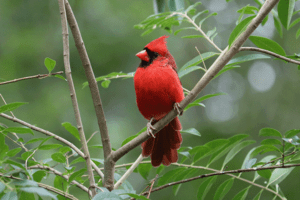
Visit one of Dripping Springs’ many parks or natural areas and you might be greeted by a few year-round locals: the northern cardinal, the Carolina chickadee or, if you’re lucky, the eastern bluebird. These Central Texas birds call Dripping Springs home. And recently, the Texas Parks and Wildlife Department and Audubon Texas recognized their home as a Bird City Texas Community. The designation is awarded to only seven other cities in the state and recognizes the city for its efforts to protect and celebrate its fluffy-winged neighbors.
“It’s a strong commitment,” said Paul Fushille, founder of the Dripping Springs Birding Club. “Getting designated isn’t where it ends. That’s just where it starts.”
This Map Shows Where Biodiversity Is Most at Risk in America
Article by New York Times
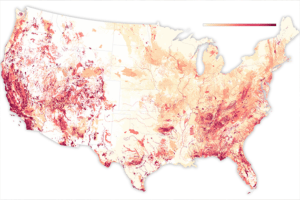
It’s the most detailed map of its kind so far. Animals like the black-footed ferret and California condor are represented, but so are groups often left out of such analyses: species of bees, butterflies, fish, mussels, crayfish and flowering plants. Not included are gray wolves, grizzly bears and other wildlife not at risk of global extinction. Maps like these offer a valuable tool to officials and conservationists who are scrambling to protect biodiversity. That work is critical, because scientists say humans are speeding extinction at a disastrous pace.
“There are hundreds of species known to be globally critically imperiled or imperiled in this country that have no protection under federal law and often no protection under state law,” said Healy Hamilton, chief scientist at NatureServe, a nonprofit conservation research group that led the analysis behind the map.
Panel addresses what Texas could have done better to prevent Rolling Pines Fire
Article by Billy Gates for KXAN
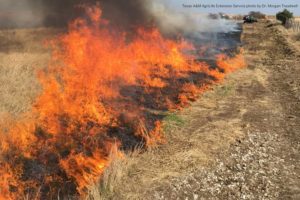
BASTROP COUNTY, Texas — An independent panel of fire experts from across the country issued its opinion and recommendations Monday about how Texas Parks and Wildlife Department personnel handled the prescribed burn that sparked the Rolling Pines Fire on Jan. 18.
Made up for wildland fire experts part of state forestry agents from Georgia, Oklahoma, Florida and South Carolina, the panel said while “quick action” from the burn boss helped mitigate damage, there should have been more firefighters on site to begin with. The fire spread past its boundaries and ended up burning 812 acres of land in Bastrop State Park, and 250 families had to be evacuated, but no buildings were damaged and no injuries were reported associated with the blaze.
Texas Parks and Wildlife approves hunting regulations, changes for 2022-23
Press Release by TPWD
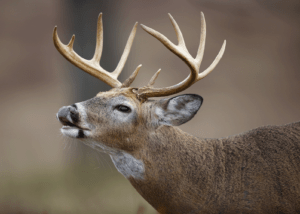
AUSTIN, Texas — Hunters should make note of these changes and follow all regulations set for species, tagging, bag limits, counties, season dates, means, and methods.
On March 24 in Austin, the Texas Parks and Wildlife Commission approved hunting regulations for the 2022-23 season at its public meeting.Commissioners adopted the following modifications and clarifications to the 2022-23 Statewide Hunting Proclamation:
Modify the definitions of “buck deer” and “antlerless deer.”; Modify the proof of sex requirements for harvested buck deer; Modify tagging and proof of sex requirements, log procedures and destination regulations for commercial cold storage facilities.
Invading Hordes of Crazy Ants May Have Finally Met Their Kryptonite
Article by UT News
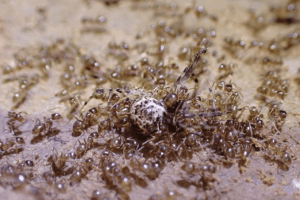
AUSTIN, Texas — When tawny crazy ants move into a new area, the invasive species is like an ecological wrecking ball — driving out native insects and small animals and causing major headaches for homeowners. But scientists at The University of Texas at Austin have good news, as they have demonstrated how to use a naturally occurring fungus to crush local populations of crazy ants.
“I think it has a lot of potential for the protection of sensitive habitats with endangered species or areas of high conservation value,” said Edward LeBrun, a research scientist with the Texas Invasive Species Research Program at Brackenridge Field Laboratory and lead author of the study.
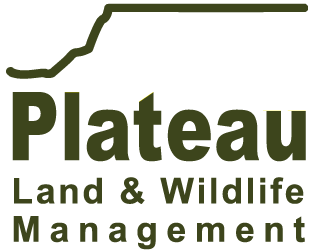





Sorry, the comment form is closed at this time.